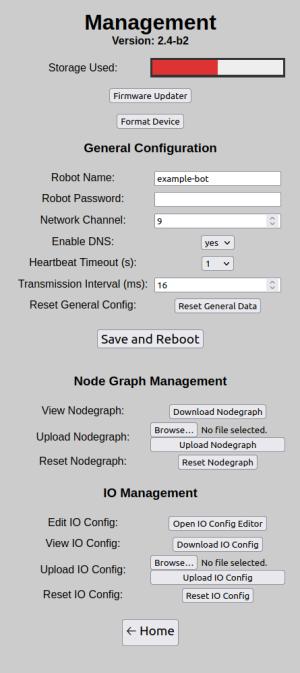The Management Page

The management page is the page where you can configure almost all aspects of the RoboPad that aren't editable in the Nodegraph Editor and IO Configuration Editor.
The page is split into 4 areas that handle storage information, general configuration, nodegraph management and input/output management.
Storage Information
At the very top of the page information and options for the entire system are displayed. Here you can see a visual indicator of the amount of storage used, as a red bar that fills a light-coloured region. In the screenshot shown to the right, 50% of the storage is used.
Below this are two buttons used to control the firmware and storage stored on the device. The Firmware Updater can be accessed by clicking on it's button, allowing you to update the firmware to the latest version (or a beta version), and all user-configured data on the device can be removed (and automatically reset to it's default values) via the Format Device button.
General Configuration
The settings under the general configuration heading reflect things that can change about the RoboPad in general - these things tend to skew towards wifi configuration settings. Since these settings are core to the RoboPad, when they are changed a reboot is required. Hence, to save any of these settings you must click the "Save and Reboot" button, which will update the settings and reboot the device. Leaving this page without clicking this button will not save the settings.
- Robot Name: The name of the RoboPad, also used as the RoboPad's local wifi network SSID. Has a maximum length of 32 characters.
- Robot Password: The password used when accessing the RoboPad's local wifi network. Has a maximum length of 32 characters.
- Network Channel: Allows you to select which of the 14 designated 2.4GHz range channels to run the RoboPad's wifi network on. In practice, performing a scan of channels in use by surrounding wifi networks and changing this to a less-populated channel might improve signal performance.
- Enable DNS: In order to let the address "robopad.local" ("start.robopad.co.uk" in versions up to 2.3) direct to "192.168.4.1" (the IP address of the RoboPad) when you are connected to the RoboPad's wifi network, a domain name server (DNS) must run on the device. While this is a relatively small service, it still takes up processing power and computation time to run. If you are comfortable with or prefer navigating to "192.168.4.1" over "robopad.local", you may disable this feature for a minor performance boost.
- Heartbeat Timeout: This is a critical safety feature of the RoboPad. In normal operation, the controller sends "heartbeat" signals to the RoboPad, letting it know that it's still connected. If these signals are not detected by the RoboPad for a certain time period, then it will assume that it has lost connection to the controller or phone and transition to the emergency stop state. This setting controls how long it takes, in seconds, before the RoboPad considers the controller disconnected. To ensure safe operation, you should set this value to as low as it can go.
- Transmission Interval: This indicates, in milliseconds, how often the controller transmits data back to the RoboPad. In practice, the controller samples things like Sliders or other UI Elements at an incredibly high sampling rate - much higher than it makes sense to transmit to the RoboPad (higher transmission rates can clog the network, particularly if there are lots of RoboPads operating in one place), so we artificially limit transmissions to only occur in batches, the time between which is controlled by this setting. This value increments in steps of 16ms, and goes from 0 (instantaneous transmission) to 496ms (batching changes from the last half-second). Note that if an incoming signal over-writes a previous one in the same batch, the latest value is transmitted, not each value in turn - i.e. it is lossy.
- Reset General Config: The Reset General Data button allows you to reset the general configuration options to their default values.
Node Graph Management
These settings give direct control over the nodegraph settings file.
- View Nodegraph: The Download Nodegraph button takes you to a page showing the direct .json file representing the nodegraph. Some browsers will show this as an explorable object, some will simply display it as text. By saving the page you are able to download a copy of the nodegraph itself. Note that like all setting configuration downloads, it will download named "info" under most web browsers - make sure you re-name the downloaded file to something memorable.
- Upload Nodegraph: This lets you upload a nodegraph file downloaded previously using the button under View Nodegraph.
- Reset Nodegraph: This resets the nodegraph to it's default configuration.
IO Management [beta version 2.4 and newer]
These settings give direct control over the input/output configuration file, and provide a link to the IO Configuration Editor.
- Edit IO Config: The Open IO Config Editor button allows you to access the input/output (IO) Configuration Editor.
- View IO Config: Similar to the View Nodegraph section, this will take you to a page that contains the raw IO configuration file. Most web browsers will immediately start downloading this file, usually titled as "info.bin". Make sure that you rename the downloaded file to something memorable.
- Upload IO Config: Similar to the Upload Nodegraph section, this lets you upload an IO configuration previously downloaded using the button under View IO Config.
- Reset IO Config: This resets the IO configuration file to it's default configuration.